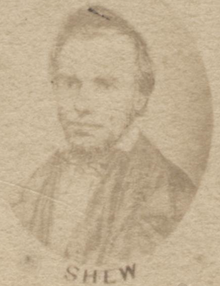Joel Shew
Joel Shew | |
|---|---|
 | |
| Born | November 13, 1816 |
| Died | October 6, 1855 |
| Occupation(s) | Hydrotherapist, writer |
Joel Shew (November 13, 1816 – October 6, 1855)[1] was an American physician, hydrotherapist, and natural hygiene advocate.
Biography
Shew was born in Providence, Saratoga County. He initially worked in a daguerreotype shop in Philadelphia before obtaining his medical degree in 1843.[2] Shew developed an interest in hydrotherapy and traveled to Gräfenberg to study Vincenz Priessnitz's techniques.[3][4] His wife, Marie Louise Shew, was also a hydrotherapist. They were friends with Mary Gove Nichols, who had temporarily lodged at their home. The Shews operated a hydrotherapy "water-cure" house and welcomed patients.[2]
In 1844, Shew established the first water-cure institution in New York City.[3] In May 1845, he opened the New Lebanon Springs Water-Cure Establishment, an institution costing approximately US$3,000.[5] He served as the co-owner and advising physician, while David Campbell managed the institution for ten years.[5] Shew was influenced by Sylvester Graham's dietary principles and promoted natural hygiene practices, including regular bathing, exercise, massage, and abstention from alcohol and tobacco.[3] Historian Stephen Nissenbaum noted that "it is clear that Shew was a Grahamite before he discovered the water-cure".[6] Both Shew and his wife were vegetarians.[7]
In 1850, Shew contributed notes and additions to the American edition of William Lambe's Water and Vegetable Diet.[8] He died in Oyster Bay, Long Island.[1] An autopsy revealed that he had an enlarged liver and internal lesions, possibly due to chemical exposure from his earlier career as a photographer.[9]
The Water-Cure Journal
In 1845, Shew launched The Water-Cure Journal, which gained significant popularity and, by 1850, had a subscription list of 50,000.[3] Russell Trall took over as editor in 1849, and the journal was later renamed The Herald of Health.[10][11][12]
Selected publications
- Facts in Hydropathy or Water Cure (1844)
- Water-Cure for Ladies (Marie Louise Shew, revised by Joel Shew, 1844)
- Hydropathy, Or, The Water-Cure (1845)
- The Water-Cure Manual (1847)
- Tobacco: Its History, Nature, and Effects on the Body and Mind (1849)
- Water and Vegetable Diet (William Lambe, notes and additions by Joel Shew, 1850)
- Consumption: Its Prevention and Cure by the Water Treatment (1851)
- The Hydropathic Family Physician (1854)
References
- ^ a b Kelly, Howard A.; Burrage, Walter L. (1920). American Medical Biographies. Baltimore: The Norman, Remington Company. p. 1045
- ^ a b Silver-Isenstadt, Jean L. (2002). Shameless: The Visionary Life of Mary Gove Nichols. Johns Hopkins University Press. p. 76. ISBN 0-8018-6848-3
- ^ a b c d Engs, Ruth Clifford. (2000). Clean Living Movements: American Cycles of Health Reform. Greenwood Publishing Group. p. 96. ISBN 0-275-97541-X
- ^ Schwarz, Richard W. (2006). John Harvey Kellogg, M.D.: Pioneering Health Reformer. Review and Herald Publishing Association. pp. 25-26. ISBN 0-8280-1039-8, 0-8280-1939-8
- ^ a b Marchese, Allison Guertin. (2014). Hidden History of Columbia County, New York. The History Press. p. 94. ISBN 978-1626193956
- ^ Nissenbaum, Stephen. (1980). Sex, Diet, and Debility in Jacksonian America: Sylvester Graham and Health Reform. Greenwood Press. p. 156. ISBN 978-0313214158
- ^ Shprintzen, Adam D. (2013). The Vegetarian Crusade: The Rise of an American Reform Movement, 1817-1921. University of North Carolina Press. p. 55. ISBN 978-1-4696-0891-4
- ^ Hoolihan, Christopher. (2001). An Annotated Catalogue of the Edward C. Atwater Collection of American Popular Medicine and Health Reform, Volume 1. University of Rochester Press. p. 603. ISBN 1-58046-098-4
- ^ Wrobel, Arthur. (1987). Pseudo-Science and Society in 19th-Century America. University Press of Kentucky. p. 81. ISBN 978-0-8131-5544-9
- ^ Whorton, James C. (2002). Nature Cures: The History of Alternative Medicine in America. Oxford University Press. pp. 90-91. ISBN 0-19-514071-0
- ^ Hoolihan, Christopher. (2008). An Annotated Catalogue of the Edward C. Atwater Collection of American Popular Medicine and Health Reform, Volume 3. University of Rochester Press. p. 344. ISBN 978-1-58046-284-6
- ^ Smith, Andrew F. (2009). Eating History: Thirty Turning Points in the Making of American Cuisine. Columbia University Press. p. 34. ISBN 978-0-231-14092-8
